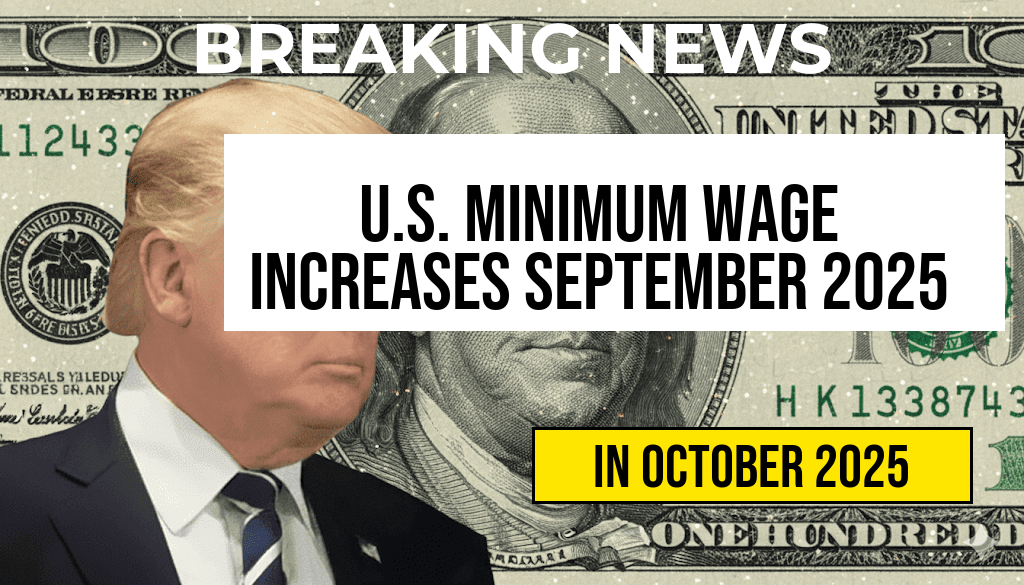The federal minimum wage in the United States is set to increase on September 30, 2025, marking a significant shift in labor compensation that affects millions of workers across the country. This increase is part of a broader initiative to address rising living costs and income inequality. As the economy continues to evolve, the push for a higher minimum wage has gained traction among lawmakers, labor advocates, and workers alike. The new hourly wage will reflect the growing demands of inflation and the cost of living, with discussions surrounding the potential impacts on businesses and the labor market. This article explores the details of the impending wage increase and provides a comprehensive list of the new hourly wages across various states.
Understanding the Minimum Wage Increase
The decision to raise the federal minimum wage has been a topic of debate for many years. Currently set at $7.25 per hour, the federal minimum has remained unchanged since 2009, despite significant increases in living expenses. As of the upcoming increase, the federal minimum wage will rise to $15.00 per hour, with phased adjustments scheduled for states that have not yet adopted their own higher wage standards.
The Phased Implementation Plan
The implementation of the new wage will occur in stages, allowing businesses to adjust to the new economic landscape. Following the increase, states will have the flexibility to adopt higher minimum wages if they choose. The phased plan is designed to minimize the impact on small businesses while ensuring that workers receive fair compensation for their labor.
State-Specific Minimum Wage Changes
Different states have varied minimum wage rates, some significantly higher than the federal minimum. Below is a list of states and their respective minimum wage rates effective September 30, 2025:
| State | Current Minimum Wage | New Minimum Wage |
|---|---|---|
| California | $15.50 | $18.00 |
| New York | $15.00 | $17.00 |
| Florida | $11.00 | $15.00 |
| Texas | $7.25 | $15.00 |
| Illinois | $13.00 | $15.00 |
Impact on Workers and Businesses
The increase in the minimum wage is expected to have profound implications for both workers and businesses. For employees, a higher wage means improved financial stability and the ability to meet basic needs such as housing, food, and healthcare. Research indicates that raising the minimum wage can also lead to increased productivity and reduced employee turnover, factors that can benefit businesses in the long run.
Conversely, some small business owners express concerns about the increased labor costs. While many acknowledge the necessity of a living wage, they argue that the rise in wages could lead to higher prices for consumers or reduced hiring. The balance between fair wages and business sustainability will be a critical conversation as the implementation date approaches.
Expert Opinions on the Wage Increase
Economists and labor experts have mixed opinions on the minimum wage increase. Proponents argue that a higher minimum wage can stimulate the economy by increasing consumer spending. According to a report from the Forbes website, raising the minimum wage could lift millions of Americans above the poverty line, thus reducing reliance on government assistance programs.
On the other hand, some experts caution that an abrupt increase could lead to job losses in sectors where profit margins are already thin. They advocate for a more gradual approach to wage increases, allowing businesses to adapt over time. The debate continues as stakeholders from various sectors engage in discussions about the best path forward.
Conclusion
The impending increase in the minimum wage on September 30, 2025, represents a pivotal moment in the landscape of labor rights and economic policy in the United States. As this date approaches, the discussions surrounding its implications will likely intensify, influencing legislative action and public opinion. For ongoing updates and further information, individuals are encouraged to monitor resources such as Wikipedia and government publications.
Frequently Asked Questions
What is the new minimum wage rate scheduled for September 30, 2025?
The new minimum wage rate set to take effect on September 30, 2025, will be $15.00 per hour, increasing from the current rate of $13.00 per hour.
Which states are affected by the minimum wage increase?
The minimum wage increase will affect all states that adhere to federal guidelines, but specific rates may vary by state due to local laws and regulations.
How often does the minimum wage change in the U.S.?
The minimum wage can change based on federal, state, or local laws, and while federal increases are infrequent, many states review and adjust their rates annually or biennially.
Are there any exemptions to the minimum wage law?
Yes, certain employees such as tipped workers, some seasonal employees, and those in specific industries may have different minimum wage requirements under federal or state law.
Where can I find the complete hourly wage list for 2025?
The complete hourly wage list for 2025, including state-specific rates and exemptions, can be found on the U.S. Department of Labor’s official website or through state labor departments.

Leave a Reply